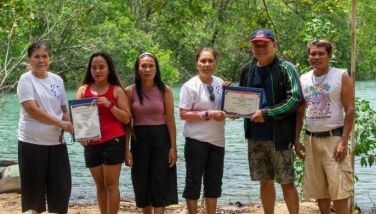Cloning for the curious
July 22, 2004 | 12:00am
In the movie The 6th Day, Arnold Schwarzenegger was shocked to find a man exactly like himself – a clone. Today, we don’t have to be shocked to learn that certain plants and animals can be duplicated down to their minute components. Various plants and animal species have been replicated. All this is due to the amazing work of genetic engineers.
A cell needs a complete set of genes to produce the whole organism. Like computer programs, genes are a set of instructions that produce every characteristic of the species, orchestrating its growth and development with precision. Because of genes, ilang-ilang trees keep their peculiar scent from tree to tree; zebras are covered by dark stripes; monkeys have tails and we don’t.
Genes are made of DNA (DeoxyriboNucleic Acid), which is written out in a language with only four letters or bases: A, C, G and T, the sequence of which directs the making of proteins. A sequence of instructions will read something like this: GAGATCTTAGCCTA. Yes, it looks like a meaningless group of garbled letters, but to living cells of a species, they mean everything. Based on the blueprint of DNA in genes, the cells create the species’ form and function defined by proteins.
Science has taught us how to manipulate genes. As pieces of DNA, genes are chemicals that are not alive. Therefore, to clone the gene, it should be placed in a live host cell like a bacterium or plant or animal cell to make the gene work or we say "to express" the gene. For instance, at the National Institute of Molecular Biology and Biotechnology (NIMBB) at the University of the Philippines (UP) Diliman, we use insect cells and yeast cells to express genes for anti-tumor antibodies. This will eventually lead to antibody therapies for breast cancer, a disease that afflicts many women, particularly Filipinas. Scientists at the International Rice Research Institute in Los Baños cloned several genes in "golden rice" that produces Vitamin A. In the future, we can look forward to coastal areas planted with salinity-resistant rice produced by PhilRice in Muñoz, Nueva Ecija – all these using gene cloning technology.
Cloning, or making exact copies of a gene, a cell, or an organism, comes from the Greek word klon, meaning twig, a tiny branch which is genetically identical to the parent plant. To clone a gene means producing several copies of a gene, letting the genes work and generating many gene products.
Clones can be natural. Identical twins are clones of a single zygote (fertilized egg). When a bacterium is cultured in a laboratory dish, it grows into a colony of cells, each of them being a clone of the original cell. Is it possible to select all the qualities of an "elite" livestock and clone its entire set of DNA (or genome)? Nowadays, it is possible! One of the ways is by "nuclear transfer," like the way Dolly was made.
The team of Ian Wilmut started with an unfertilized egg from an ewe (pronounced "yoo"), a female sheep. Let’s call her Ewe No 1. They removed the nucleus of the egg, making the egg "enucleated" or devoid of all nuclear materials. They took the nucleus from a mammary cell of another ewe, Ewe No. 2. With an electric shock, the nucleus fused with the enucleated egg (nuclear transfer) and the egg was activated. The resulting embryo was cultured and then implanted into the uterus of a surrogate mother ewe, Ewe No. 3, which carried it to full term. Then Dolly was born. She was a striking image of Ewe No. 2 – the result of an all-female production.
Was Dolly a 100 percent genetic duplicate of Ewe No. 2? No, not really. She was made from the nucleus of Ewe No. 2 which was introduced into the cytoplasm (enucleated egg) of Ewe No 1. The recipient cytoplasm had mitochondrial genes of Ewe No. 1 which were different from those of Ewe No 2.
Even with some successes in cloning genes in pigs, cows and goats, genetic modification in commercial livestock has not really taken off. "Normal breeding," says Harry Griffin, director of Roslin Institute, the home of Dolly, "is more effective and easier." But some leading drug companies are into "pharming" – designing lactating farm animals as factories for pharmaceuticals. Animals like goat or sheep carry genes for therapeutic proteins that are secreted in their milk.
Twins are made from a single embryo that splits into two. They have identical nuclei and cytoplasm. During gestation, the twins are located in different places in the same womb, which may affect gene expression differently. They are born in succession, and that affects them, too. As the babies grow up, they are subject to different experiences. They may be DNA clones of each other, but are not clones of their mother.
Those hoping to use nuclear transfer to clone their loved ones, whether human or pet, will be very disappointed. This cloning technique is not a method for making exact copies of adult animals much less of grown people. The reason is that the physique and personality of an individual is a combined result of his genetic makeup as well as his upbringing and experience. Memory, for instance, is not clonable.
Genetic engineering has made such significant strides that both the academe and the business world have been awestruck. The 21st century is truly the "Biotechnology Century" with an avalanche of advances in technology. A rundown of the latest projects is astounding: attempts to coax bacteria to produce magnets, or marine organisms to manufacture unusual materials, and even an ambitious venture to clone the extinct woolly mammoth! With these possibilities, we can only imagine how cloning will revolutionize the way we live.
Despite the claims of success in human cloning, the technology is far from polished. It took 276 errors before Dolly was made. Recently, the journal Nature reports that when scientists at Tokyo University created female mice from all-female parents, the success rate of the expensive cloning experiment was only two out of 598 mice.
The issue on patents and regulations has also generated its share of controversy. Who owns the genes, and to what extent scientists are allowed to manipulate genes are just two of the many questions that we as a society will have to deal with.
However, speaking as a wife and mother, I don’t think cloning will replace the time-honored way of reproduction. There is no courtship, no romance in cloning. So finding exact copies of Arnie Schwarzenegger happens only in the movies.
Virginia D. Monje, Ph.D. in Molecular Biology and Biotechnology, is a professor of the National Institute of Molecular Biology and Biotechnology of the University of the Philippines in Diliman, Quezon City. For comments, e-mail [email protected].
A cell needs a complete set of genes to produce the whole organism. Like computer programs, genes are a set of instructions that produce every characteristic of the species, orchestrating its growth and development with precision. Because of genes, ilang-ilang trees keep their peculiar scent from tree to tree; zebras are covered by dark stripes; monkeys have tails and we don’t.
Genes are made of DNA (DeoxyriboNucleic Acid), which is written out in a language with only four letters or bases: A, C, G and T, the sequence of which directs the making of proteins. A sequence of instructions will read something like this: GAGATCTTAGCCTA. Yes, it looks like a meaningless group of garbled letters, but to living cells of a species, they mean everything. Based on the blueprint of DNA in genes, the cells create the species’ form and function defined by proteins.
Science has taught us how to manipulate genes. As pieces of DNA, genes are chemicals that are not alive. Therefore, to clone the gene, it should be placed in a live host cell like a bacterium or plant or animal cell to make the gene work or we say "to express" the gene. For instance, at the National Institute of Molecular Biology and Biotechnology (NIMBB) at the University of the Philippines (UP) Diliman, we use insect cells and yeast cells to express genes for anti-tumor antibodies. This will eventually lead to antibody therapies for breast cancer, a disease that afflicts many women, particularly Filipinas. Scientists at the International Rice Research Institute in Los Baños cloned several genes in "golden rice" that produces Vitamin A. In the future, we can look forward to coastal areas planted with salinity-resistant rice produced by PhilRice in Muñoz, Nueva Ecija – all these using gene cloning technology.
Cloning, or making exact copies of a gene, a cell, or an organism, comes from the Greek word klon, meaning twig, a tiny branch which is genetically identical to the parent plant. To clone a gene means producing several copies of a gene, letting the genes work and generating many gene products.
Clones can be natural. Identical twins are clones of a single zygote (fertilized egg). When a bacterium is cultured in a laboratory dish, it grows into a colony of cells, each of them being a clone of the original cell. Is it possible to select all the qualities of an "elite" livestock and clone its entire set of DNA (or genome)? Nowadays, it is possible! One of the ways is by "nuclear transfer," like the way Dolly was made.
The team of Ian Wilmut started with an unfertilized egg from an ewe (pronounced "yoo"), a female sheep. Let’s call her Ewe No 1. They removed the nucleus of the egg, making the egg "enucleated" or devoid of all nuclear materials. They took the nucleus from a mammary cell of another ewe, Ewe No. 2. With an electric shock, the nucleus fused with the enucleated egg (nuclear transfer) and the egg was activated. The resulting embryo was cultured and then implanted into the uterus of a surrogate mother ewe, Ewe No. 3, which carried it to full term. Then Dolly was born. She was a striking image of Ewe No. 2 – the result of an all-female production.
Was Dolly a 100 percent genetic duplicate of Ewe No. 2? No, not really. She was made from the nucleus of Ewe No. 2 which was introduced into the cytoplasm (enucleated egg) of Ewe No 1. The recipient cytoplasm had mitochondrial genes of Ewe No. 1 which were different from those of Ewe No 2.
Even with some successes in cloning genes in pigs, cows and goats, genetic modification in commercial livestock has not really taken off. "Normal breeding," says Harry Griffin, director of Roslin Institute, the home of Dolly, "is more effective and easier." But some leading drug companies are into "pharming" – designing lactating farm animals as factories for pharmaceuticals. Animals like goat or sheep carry genes for therapeutic proteins that are secreted in their milk.
Twins are made from a single embryo that splits into two. They have identical nuclei and cytoplasm. During gestation, the twins are located in different places in the same womb, which may affect gene expression differently. They are born in succession, and that affects them, too. As the babies grow up, they are subject to different experiences. They may be DNA clones of each other, but are not clones of their mother.
Those hoping to use nuclear transfer to clone their loved ones, whether human or pet, will be very disappointed. This cloning technique is not a method for making exact copies of adult animals much less of grown people. The reason is that the physique and personality of an individual is a combined result of his genetic makeup as well as his upbringing and experience. Memory, for instance, is not clonable.
Genetic engineering has made such significant strides that both the academe and the business world have been awestruck. The 21st century is truly the "Biotechnology Century" with an avalanche of advances in technology. A rundown of the latest projects is astounding: attempts to coax bacteria to produce magnets, or marine organisms to manufacture unusual materials, and even an ambitious venture to clone the extinct woolly mammoth! With these possibilities, we can only imagine how cloning will revolutionize the way we live.
Despite the claims of success in human cloning, the technology is far from polished. It took 276 errors before Dolly was made. Recently, the journal Nature reports that when scientists at Tokyo University created female mice from all-female parents, the success rate of the expensive cloning experiment was only two out of 598 mice.
The issue on patents and regulations has also generated its share of controversy. Who owns the genes, and to what extent scientists are allowed to manipulate genes are just two of the many questions that we as a society will have to deal with.
However, speaking as a wife and mother, I don’t think cloning will replace the time-honored way of reproduction. There is no courtship, no romance in cloning. So finding exact copies of Arnie Schwarzenegger happens only in the movies.
BrandSpace Articles
<
>
- Latest
Latest
Latest
October 24, 2024 - 11:20am
October 24, 2024 - 11:20am
October 14, 2024 - 11:00am
October 14, 2024 - 11:00am
October 11, 2024 - 12:49pm
October 11, 2024 - 12:49pm
September 30, 2024 - 8:00am
September 30, 2024 - 8:00am
September 26, 2024 - 2:00pm
September 26, 2024 - 2:00pm
September 3, 2024 - 1:00pm
September 3, 2024 - 1:00pm
Recommended






























